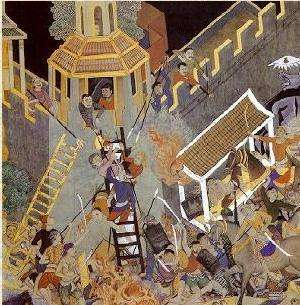South-East Asia campaign of Rajendra Chola I
Inscriptions and historical sources assert that the Medieval Chola king Rajendra Chola I sent a naval expedition to Indochina, the Malay Peninsula and Indonesia in 1025 in order to subdue Srivijaya.[1] The Thiruvalangadu plates, the Leyden grant, and the Tamil stele of Rajendra Chola I are the principal sources of information about the campaign.
Sources
The most detailed source of information on the campaign is the Tamil stele of Rajendra Chola I.[2] The stele states:
(Who) having despatched many ships in the midst of the rolling sea and having caught Sangrāma-vijayōttunga-varman, the king of Kadāram, together with the elephants in his glorious army, (took) the large heap of treasures, which (that king) had rightfully accumulated; (captured) with noise the (arch called) Vidhyādharatorana at the "war gate" of his extensive city, Śrī Vijaya with the "jewelled wicket-gate" adorned with great splendour and the "gate of large jewels"; Paṇṇai with water in its bathing ghats; the ancient Malaiyūr with the strong mountain for its rampart; Māyuriḍingam, surrounded by the deep sea (as) by a moat; Ilangāśōka (i.e. Lankāśōka) undaunted in fierce battles; Māpappālam having abundant (deep) water as defence; Mēviḷimbangam having fine walls as defence; Vaḷaippandūru having Viḷappandūru (?); Talaittakkōlam praised by great men (versed in) the sciences; Mādamālingam, firm in great and fierce battles; Ilāmuridēśam, whose fierce strength rose in war; Mānakkavāram, in whose extensive flower gardens honey was collecting; and Kadāram, of fierce strength, which was protected by the deep sea[2][3]
The Thiruvalangadu plates, from the fourteenth year of Rajendra Chola I, mentions his conquest of Kadaram but does not go into the details.[2] The first attempt by someone from outside India to identify the places associated with the campaign was made by epigraphist E. Hultzsch, who had published the stele in 1891.[4] Hultzsch identified the principalities mentioned in the inscription with places ruled by the Pandyan Dynasty.[4] In 1903, he rescinded his theory and stated that the stele described Rajendra Chola I's conquest of Bago in Burma.[4] George Coedès' Le Royaume de Sri Vijaya published in 1918 after several years of research, rejected both the theories and provided the first convincing description of Rajendra Chola I's conquest of Southeast Asia.[5]
Causes
The relation between Srivijaya and the Chola dynasty of southern India was initially friendly during the reign of Raja Raja Chola I. In 1006 CE a Srivijayan Maharaja from Sailendra dynasty, king Maravijayattungavarman, constructed the Chudamani Vihara in the port town of Nagapattinam.[6] However, during the reign of Rajendra Chola I the relations deteriorate as the Chola Dynasty started to attack Srivijayan cities.[7]
The causes of the hostility are obscure.[1] While some scholars opine that the campaign was undertaken to establish Chola dominance over the seas of South-East Asia, other suggest that it might have been a war of plunder.[1] It seems that the Khmer king Suryavarman I of the Khmer Empire requested aid from the powerful Chola Emperor Rajendra Chola I of the Chola dynasty against Tambralinga kingdom .[8] After learning of Suryavarman's alliance with Rajendra Chola, the Tambralinga kingdom requested aid from the Srivijaya king Sangrama Vijayatungavarman.[8][9] This eventually led to the Chola Empire coming into conflict with the Srivijiya Empire. The war ended with a victory for the Chola dynasty and Angkor Wat of the Khmer Empire, and major losses for the Sri Vijaya Empire and the Tambralinga kingdom.[8][9]
Conquests

- Sri Vijaya
The stele of Rajendra Chola I mentions Sri Vijaya as the first of the countries conquered.[10] The Tamil inscription lists Sri Vijaya with "its jewelled wicket-gate" and "a gate of large jewels" as the first of the treasures captured by the fleet. The Sri Vijaya, mentioned in the inscriptions, has been identified by Coedès with the Sri Vijaya kingdom which rule from its base at Palembang in South Sumatra.[10]
- Pannai
Pannai, with its bathing ghats, is second of the lands to be conquered by the naval fleet. Pannai has been identified as Panai or Pane, a city on the eastern coast of North Sumatra,[10] located on the estuary of Panai River and Barumun River.
- Malaiyur
Malaiyur, with "its strong mountain", has been identified with Malayu in today Jambi province in Batanghari river valley, where a strong principality flourished at that time. Other suggestion is the southern part of the Malay peninsula[10]
- Mayirudingam
Mayirudingam is believed to be the same as Ji-lo-ting listed by the Chinese writer Chau Ju-Kua among the dependencies of Sri Vijaya and is identified with the city of Chaiya in the centre of the Malay peninsula.

- Ilangasoka
The land of Ilangasoka (Langkasuka) mentioned in the inscriptions has been located on the east coast of the Malay Peninsula and is believed to be the same as the province of Ling-ya-sseu-kia mentioned in Chau Ju-Kua's list.
- Mapappalam
The epigraphist V. Venkayya identifies Mapappalam of the inscription with the city of Papphalama mentioned in the Mahavamsa.[11] The place is believed to be located in the Talaing region of Lower Burma.[11]
- Talaittakkolam
Talaittakkolam is believed to be the same as Takkola mentioned by Ptolemy and is identified with the modern-day city of Takuapa in the Isthmus of Kra.[11][12]
- Nakkavaram
Nakkavaram, mentioned in the records, has been identified by V. Venkayya with the Nicobar Islands.[5]
- Kadaram
The place Kadaram (modern Kedah) mentioned in the stele is identified with the Kataha of Sanskrit literature and Kadaram of the Kalingattuparani and the Kiet-cha of the Chinese chronicles.[13][14]
Results
The Southeast Asia campaign intensified interactions between India and Southeast Asia. The campaign also led to the establishment of diplomatic ties with China. The first Indian embassy to the court of the Song Emperor was sent by Raja Raja Chola I in 1015.[6] This was followed by a second embassy by his son, Rajendra Chola I, in 1033 and a third by Kulothunga Chola I in 1077.[6] The Chola Empire did not establish its direct rule over South-East Asia thought they might have levied a periodic tribute.[6]
Traders from the Tamil country firmly established themselves over various parts of South-East Asia. A merchant guild was set up in Burma and another in Sumatra in 1088.[6] Indian historian V. R. Ramachandra Dikshitar suggests that Tamil traders of the Chola period might have had a knowledge of Australia and Polynesia.[15][16]
Notes
- 1 2 3 Kulke, p 212
- 1 2 3 Sastri, p 211
- ↑ Majumdar, R. C. (1937). Ancient Indian colonies in the Far East. 2: Suvarnadvipa. Dacca: Ashok Kumar Majumdar. pp. 167–190.
- 1 2 3 Sastri, p 212
- 1 2 Sastri, p 213
- 1 2 3 4 5 Sastri, pp 219–220
- ↑ Power and Plenty: Trade, War, and the World Economy in the Second Millennium by Ronald Findlay,Kevin H. O'Rourke p.67
- 1 2 3 Kenneth R. Hall (October 1975), "Khmer Commercial Development and Foreign Contacts under Sūryavarman I", Journal of the Economic and Social History of the Orient 18 (3), pp. 318-336, Brill Publishers
- 1 2 R. C. Majumdar (1961), "The Overseas Expeditions of King Rājendra Cola", Artibus Asiae 24 (3/4), pp. 338-342, Artibus Asiae Publishers
- 1 2 3 4 Sastri, p 215
- 1 2 3 Sastri, p 216
- ↑ Arokiaswamy, Celine W.M. (2000). Tamil Influences in Malaysia, Indonesia, and the Philippines. Manila s.n. p. 46.
- ↑ Sastri, p 217
- ↑ Sastri, p 218
- ↑ Dikshitar, V. R. Ramachandra (1947). Origin and Spread of the Tamils. Adyar Library. p. 30.
- ↑ Gupta, S. M. (1995). The Indian origin of New Zealand's Maori. Hindu World Publications. p. 61.
Bibliography
- Kulke, Hermann; Kesavapany, K.; Sakhuja, Vijay (2009). Nagapattinam to Suvarnadwipa: Reflections on Chola naval expeditions to Southeast Asia. Institute of Southeast Asian Studies. ISBN 9812309365, ISBN 978-981-230-936-5.
- Sastri, K. A. Nilakanta (2000) [1935]. The Cōlas. Madras: University of Madras.


